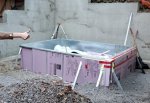Hello TFP,
First time poster and soon to be first time pool owner. It is so nice to find a site that is user supported like this.
We are installing a small pool in our small backyard (10' X 8' X 5' deep, vinyl liner pool). Our location is Ottawa, Ontario. The main use of the pool will be as a cold plunge pool that we can jump into after a hot sauna. The ideal temperature for our cold plunge pool will be somewhere in the 10-15C range (50-60F). Ideally we would like to be able to use the pool year round. For the cold months we are installing a gas heater (200,000BTUs). I'm going with gas rather than a heat pump because I want to be able to occasionally crank the pool temperature way up for an almost hot tub like experience, even in winter (although most likely we will close the pool from Dec to Mar to avoid insanely high heating costs and electricity costs from running the pump 24/7 to prevent freezing). Mostly, however, it will be for cold plunging, especially in the summer.
My problem is that without some sort of cooling ability the pool will be well above our desired temperature from June to late August. I've read that a heat pump and/or chiller can do this, but I have neither the room nor the money for yet another pool device. My idea is to use the relatively constant ground temperature as a cooling source. The ground temperature at a depth of 3m (about 9 feet) never gets above about 10C, and even at a depth of 2m (6 feet) the temp never gets above about 12.5C (see Fig 1 below). The idea is to dig a couple of trenches around 8 feet deep and bury some loops of polyethylene pipe (much like for a horizontal loop geothermal system as in image 2 below) and then run the pool water through this. I should be able to get a total of about 200 feet of pipe burried. The backyard is being dug up anyways for other landscaping work, so it is not a major task to dig a couple of trenches.
Does anyone know if I would get effective cooling of the pool water in this way?
Can a typical pool pump handle pushing water through this much pipe? It would only go through this system when cooling is needed, so about 2 months of the year.
Any thoughts would be greatly appreciated.
I know some will think this is frivolous to want to cool the water for 2 months of the year. But to me spending all this effort and money on building the pool is kind of wasted if the water is not refreshing during the hotest months of the year. And the prospect of going from a hot sauna to a warm 'bathtub' is quite unappealing.
I have also attached a pic of the pool in progress.
Thank you!!



First time poster and soon to be first time pool owner. It is so nice to find a site that is user supported like this.
We are installing a small pool in our small backyard (10' X 8' X 5' deep, vinyl liner pool). Our location is Ottawa, Ontario. The main use of the pool will be as a cold plunge pool that we can jump into after a hot sauna. The ideal temperature for our cold plunge pool will be somewhere in the 10-15C range (50-60F). Ideally we would like to be able to use the pool year round. For the cold months we are installing a gas heater (200,000BTUs). I'm going with gas rather than a heat pump because I want to be able to occasionally crank the pool temperature way up for an almost hot tub like experience, even in winter (although most likely we will close the pool from Dec to Mar to avoid insanely high heating costs and electricity costs from running the pump 24/7 to prevent freezing). Mostly, however, it will be for cold plunging, especially in the summer.
My problem is that without some sort of cooling ability the pool will be well above our desired temperature from June to late August. I've read that a heat pump and/or chiller can do this, but I have neither the room nor the money for yet another pool device. My idea is to use the relatively constant ground temperature as a cooling source. The ground temperature at a depth of 3m (about 9 feet) never gets above about 10C, and even at a depth of 2m (6 feet) the temp never gets above about 12.5C (see Fig 1 below). The idea is to dig a couple of trenches around 8 feet deep and bury some loops of polyethylene pipe (much like for a horizontal loop geothermal system as in image 2 below) and then run the pool water through this. I should be able to get a total of about 200 feet of pipe burried. The backyard is being dug up anyways for other landscaping work, so it is not a major task to dig a couple of trenches.
Does anyone know if I would get effective cooling of the pool water in this way?
Can a typical pool pump handle pushing water through this much pipe? It would only go through this system when cooling is needed, so about 2 months of the year.
Any thoughts would be greatly appreciated.
I know some will think this is frivolous to want to cool the water for 2 months of the year. But to me spending all this effort and money on building the pool is kind of wasted if the water is not refreshing during the hotest months of the year. And the prospect of going from a hot sauna to a warm 'bathtub' is quite unappealing.
I have also attached a pic of the pool in progress.
Thank you!!





